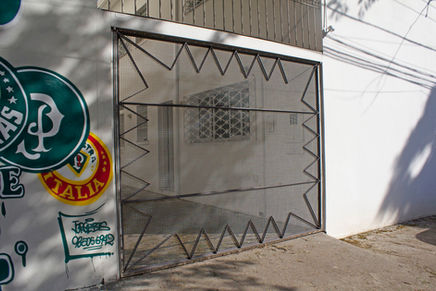FACHADA 2e1
Débora Bolzsoni _ Wagner Malta Tavares _ Laura Vinci
Photos: courtesy of the artist
Débora Bolzsoni | Luminoso de portão e Sing Board
Replacement of the house's garage door with one designed by the artist, outdoor lighting and burnt sand sculpture
Photos: courtesy of the artist
Wagner Malta Tavares | Space Invaders
light and zinc
Photos: Inês Bonduki
Laura Vinci | Noturna
light and integral graphite drawing on the facade reproducing the projection of the shadows from trees and electrical wires located in front of the house
[automatically translated]
Located in a region of small houses that occupy two blocks between the Palestra Itália stadium and the Bourbon and West Plaza shopping malls, the house from the 1980s, where Ateliê Coletivo 2E1 operates, is one of the few in the region that has not yet been bought and expropriated to start the construction of two real estate developments. The proposal for the façade project 2E1* for 2014, supported by Proac Artes Visuais, is that the invited artists discuss throughout the year the relationship between the architecture and the urban situation of this house with the surroundings, which are currently undergoing a radical transformation.
Between March and May, Débora Bolzsoni presented ‘Luminoso de gate’ and ‘Signboard’, where she took as a starting point the urban furniture device, the garage door that forms part of the façade. In the intervention, the gate leaf, which interrupts the view of the interior of the house's backyard, is replaced by a semi-transparent grid made of the same material as the grids of the surrounding houses, but with a 'splash' of an empty advertisement. Through the gate, one can see a fragile sculpture made of burnt sand that has just been pressed into the shape of an easel, also a strategy for urban communication, which in this case communicates nothing, and which falls apart during the two months the installation is on display.
Between June and August, Wagner Malta Tavares took the video game Space Invaders, created in the late 1970s, as a starting point for his intervention. The work makes reference to pop culture and science fiction, present throughout the artist's career. The ‘animals’, game characters, are reproduced in zinc on the house’s facade, and behind them a green light – like the one in the game – creates an outline. During the night, the increased intensity of the green light magnifies the estrangement, reverting the façade into an alien body in the cityscape. The work takes an ironic look at contemporary architecture, at buildings with mirrored or metallic cladding, which for some time now cover the landscape of large cities.
Finally, Laura Vinci occupies the façade between November 2014 and January 2015. Noturna is a large drawing created directly on the façade of the House. This design registers, and immobilizes on the facade, the shadow of the tree and the wiring, present in front of the house. In this way, the artist fixes a certain moment, registers imprecisely, due to the movement of the wind, the shadow of the tree and the wires that the street lighting projects. Thus, a reflection on the passage of time and the transience of things is established.
In some way Noturna also makes explicit the impermanence of architecture in the city. During 2014, the other houses on the street, commercial and residential, were gradually deactivated, bought and emptied to make way for large real estate developments. The urban situation in the region, the starting point of the projects, changed during 2014. Rua Teixeira e Silva from March 2014, when the project started, is no longer the same now. No major alterations to the street have been made yet, but the gradual deactivation of residences and businesses on the street, reconfigured the space in a short time, and point to an even more marked transformation in the coming years.
Douglas de Freitas























